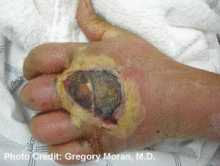VIENNA - Predictors of clinical failure in the treatment of complicated skin and skin structure infections in diabetic patients due to methicillin-resistant Staphylococcus aureus include involvement of a body area other than the lower extremities, according to an analysis combining the results of three large, prospective, randomized, phase III/IV clinical trials.
The other independent predictors of treatment failure in diabetic patients were
comorbid peripheral vascular disease and polymicrobial pathogens, Dr. Benjamin A. Lipsky reported at the annual European Congress of Clinical Microbiology and Infectious Diseases.
The presence of these risk factors, each of which roughly doubled the likelihood of treatment failure, should serve to alert physicians to an elevated risk of poor outcome, added Dr. Lipsky of the Veterans Affairs Puget Sound Health Care System and the University of Washington, Seattle.
He reported on 845 patients with complicated skin and skin structure infections due to MRSA who participated in three open-label clinical trials involving randomization to treatment with linezolid or vancomycin. A total of 34% of participants were diabetic.
This is believed to be the largest-ever analysis of predictors of clinical failure in patients with skin infections caused by MRSA, according to the internist.
Clinical failure was defined as persistence or progression of clinical signs and symptoms of active infection at the study's end, which came variously 6-28 days after the last dose of study medication.
The presence of comorbid peripheral vascular disease was associated with a 2.3-fold increased risk of clinical treatment failure in the diabetic patients. It's likely that the vascular disease interferes with delivery of antimicrobial agents to the site of infection, Dr. Lipsky observed.
In nondiabetic patients, two independent predictors of clinical treatment failure were identified: vancomycin therapy and the presence of polymicrobial pathogens. Each was associated with a 2.2-fold increased risk of treatment failure.
Numerous other variables were scrutinized as potential predictors of clinical treatment failure but failed to achieve significance. Among them were the type of infection - abscess, ulcer, cellulitis, or surgical wound - as well as age, gender, body weight, renal impairment, and cardiac comorbidity.
This study was sponsored by Pfizer. Dr. Lipsky serves as a consultant to the company.


